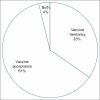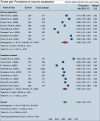Coronavirus Disease 2019 Vaccine Hesitancy and Acceptance among the Indian Population: A Systematic Review and Meta-analysis
- PMID: 40290207
- PMCID: PMC12021345
- DOI: 10.4103/jgid.jgid_129_24
Coronavirus Disease 2019 Vaccine Hesitancy and Acceptance among the Indian Population: A Systematic Review and Meta-analysis
Abstract
Introduction: The disastrous impact of the coronavirus disease 2019 (COVID-19) pandemic worldwide necessitated the prompt development of vaccines to combat the situation; however, vaccination drives have been challenged by vaccine hesitancy among several communities across geographies. Understanding vaccine hesitancy and acceptance can help design appropriate vaccination strategies. With this background, a systematic review and meta-analysis were conducted to estimate the prevalence and assess the factors associated with vaccine hesitancy and acceptance among the Indian population.
Methods: This systematic review is reported following the Preferred Reporting Items for Systematic Reviews and Meta-Analyses guidelines. The data were extracted from May 1, 2024, to May 30, 2024, using PubMed, Scopus, and DOAJ search engines. The keywords used in the search string are "COVID-19," "vaccine hesitancy," "vaccine acceptance," and "India." Finally, 26 articles were selected, and the included articles underwent a quality assessment with the help of the JBI-Checklist for cross-sectional studies. The pooled vaccine hesitancy and acceptance prevalence was estimated at a 95% confidence interval (CI) using a random effect model assuming potential heterogeneity. Analysis used Stata Now 18 SE (Stata Corp., College Station, TX, USA).
Results: Of the 26 studies, 14 studies were conducted among healthcare workers, seven studies among the general population, two studies among pregnant women and one each among school children, parents, and socioeconomically disadvantaged people. The reported highest vaccine acceptance was 92.74% and 86.3%, and hesitancy was 60.8% and 50% among healthcare workers and the general population, respectively. Between the general population and healthcare workers, the estimated pooled prevalence of vaccine acceptance is 66.1% (95% CI: 53%-78%) and 65.9% (95% CI: 57%-74%), respectively. The estimated pooled prevalence of vaccine hesitancy is 33% (95% CI: 20%-46%) among the general population and 24% (95% CI: 11%-40%) among healthcare workers. With the random effect model, high heterogeneity was observed in both acceptance (I 2 >99%) and hesitancy (I 2 >98%).
Conclusion: A significant variation in the acceptability of the COVID-19 vaccine has been reported across different regions of India. Hence, future research is needed to enable comparability and generalizability, as the variations may also reflect differences in study designs, demographics, and time frames.
Keywords: Acceptance; confidence; eagerness; hesitancy; resistance; willingness.
Copyright: © 2025 Journal of Global Infectious Diseases.
Conflict of interest statement
There are no conflicts of interest.
Figures









Similar articles
-
COVID-19 Vaccine Hesitancy: Umbrella Review of Systematic Reviews and Meta-Analysis.JMIR Public Health Surveill. 2024 Apr 30;10:e54769. doi: 10.2196/54769. JMIR Public Health Surveill. 2024. PMID: 38687992 Free PMC article.
-
COVID-19 vaccine acceptance and hesitancy in Cameroon: a systematic review and meta-analysis.BMC Public Health. 2025 Mar 17;25(1):1035. doi: 10.1186/s12889-025-22195-4. BMC Public Health. 2025. PMID: 40097975 Free PMC article.
-
COVID-19 Vaccine Hesitancy among Adults in India: A Systematic Review and Meta-analysis.Indian J Public Health. 2024 Oct 1;68(4):534-540. doi: 10.4103/ijph.ijph_939_23. Epub 2024 Dec 13. Indian J Public Health. 2024. PMID: 39670935
-
COVID-19 vaccine hesitancy among healthcare workers in Arab Countries: A systematic review and meta-analysis.PLoS One. 2024 Jan 2;19(1):e0296432. doi: 10.1371/journal.pone.0296432. eCollection 2024. PLoS One. 2024. PMID: 38166119 Free PMC article.
-
COVID-19 vaccine hesitancy in Turkey: A systematic review and meta-analysis.Epidemiol Infect. 2023 Nov 24;151:e199. doi: 10.1017/S0950268823001875. Epidemiol Infect. 2023. PMID: 37997650 Free PMC article.
References
-
- World Health Organization. Corona Virus Disease (COVID-19) Pandemic. [[Last accessed on 2024 May 02]]. Available from: https://www.who.int/emergencies/diseases/novel-coronavirus-2019 .
-
- Worldometer. COVID-19 Coronavirus Pandemic. 2022. [[Last accessed on 2024 May 02]]. Available from: https://www.worldometers.info/coronavirus/
LinkOut - more resources
Full Text Sources
